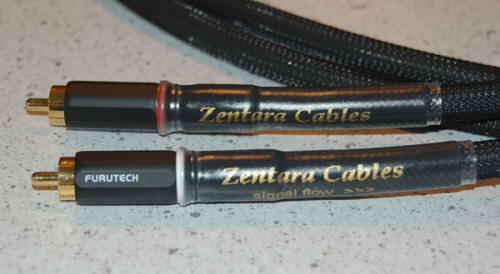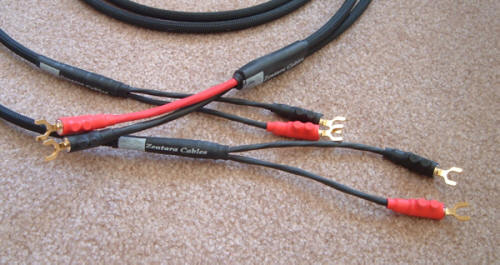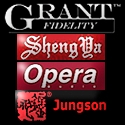
You are reading the older HTML site
Positive Feedback ISSUE
42march/april 2009
zentara cables
IC-4 interconnect and TF-8 speaker cables
as reviewed by Kent Johnson

|
KENT JOHNSON'S SYSTEM
LOUDSPEAKERS
ELECTRONICS
SOURCES
CABLES
ACCESSORIES SECOND SYSTEM
LOUDSPEAKERS
ELECTRONICS
SOURCE
CABLES
ACCESSORIES
|
Zentara Cables are designed and built by V. Neng Kue in Canton, Michigan. Each cable is hand-made to the buyer's specifications regarding length and termination. There are two ranges of cables offered by Zentara, the Standard and the Signature.
The term Standard is something of a misnomer as these are actually premium cables by… well, by any standard. I have been listening to Zentara's TF-8 speaker cables (in an 8 foot bi-wire configuration) and two pairs of IC-4 interconnect cables. The speaker cables sell for $800 as configured and the 1 meter interconnects for $400 each pair.
The Standard cable range uses proprietary pure copper wire made for Zentara in the United States. The RCA plugs and spades are made by Furutech. All insulation used in the cables is pure Teflon. The IC-4 interconnect cables are shielded using both aluminum/mylar foil and braided copper; the speaker cables are not shielded.
Cosmetically, these cables are best described as "understated." Their construction quality is however extremely high. They feel substantial and it is clear that a lot of attention to detail has gone into their design and construction. They are also moderately stiff.
Neng feels that the Standard cables will work best in audio systems up to the $10,000 range. His Signature cables are designed for more expensive systems—systems that offer the additional detail that the Signature cables are designed to reveal.
I met Neng at Rocky Mountain Audio Fest where we discussed my reviewing his cables. Due to a misunderstanding on my part as to the quality levels of his two cable ranges, we agreed that he would send me a set of Standard cables for my living room system. It was only after I received them that I realized that I should have had him send me cables configured for my main system. These things happen in the fog of audio shows. Happily, this has proven to be no hardship, as I have had a chance to listen to Neng's cables in both of my systems.
Neng Kue immigrated to the United States from Laos as a child. He has graduate degrees in both Materials Science and Manufacturing and has worked in the aerospace and automotive industries as a wire engineer. He has also been an audiophile for over twenty years and, like other people in the audio industry, decided that he could make a better 'cable' than those to which he was listening.
Neng has spent the past eight years thinking about cable design and building prototypes. He has listened to these cables in his own system and offered them to local audiophiles to try in their systems. He refined the construction and materials used in his cables until he felt he had cables which he could bring to market. Neng's design goals are to make cables that offer a "balanced, neutral, and musical sound," that is cables that do not emphasize any portion of the frequency spectrum at the expense of another.
Listening to the TF-8 speaker cables
I have had the Zentara Cables since the first of the year. This has given me the opportunity to listen to the TF-8 speaker cables in my main listening room with the Grant Fidelity A-534B amp, the Shengya A-216 hybrid amp, and my own reference Dodd/Rogue set up; all with Quad 21L2 speakers, which are designed for bi-wiring.

When I first listened to the Grant Fidelity A-534B amplifier with the Quads, the Zentara TF-8 cables had had virtually no break-in time. Neng assured me that they needed very little and ten hours or so would be enough. I noted at the time that Tierney Sutton's CD, Something Cool (Telarc CD-83548) had the same gorgeous midrange that I had been enjoying with my reference cables and as such, had lost nothing in terms of detail, soundstaging, or air. The Quad's bass, however, was noticeably more detailed and subjectively deeper via the TF-8 cabling.
On "St. Paul's Suite" with the English Chamber Orchestra (Nimbus NI 5032) I noted better bass depth and detail as well. I could also follow the organ, which is fairly low in level in the Albinoni "Adagio," much more easily with the TF-8s. Soundstaging was excellent and the sense of the recorded space was very clearly presented.
I went from the A-534B to my reference Dodd/Rogue combination. The midrange gorgeousness of the 300B tubes was exchanged for what I would characterize as midrange "realism." Voices were still lovely, just not as breathtakingly stunning.
This midrange "loss" was offset by gains in overall detail and bass definition. Double bass and cello through the Zentara cables were impressively reproduced by the Quad's single 6.5-inch mid/bass driver on both classical and jazz CDs. The cello on the Tokyo String Quartet's performance of Britten's "String Quartet Number 2, Opus 36," was reproduced with extremely satisfying depth, definition, and volume. The violins and viola were reproduced with no trace of shrillness but instead with a satisfying vivacity and an excellent sense of the recorded space (RCA 09026-61387-2).
Jackson Browne's Solo Acoustic Vol.1 (Inside Recordings INR5205-2) offered an improved sense of the recording venue through the TF-8 cables. Applause and audience comments were more intelligible than I had previously heard. The low notes of the piano sounded subjectively deeper as well.
I listened to quite a few CDs with the Dodd/Rogue/Quad set up, but one that stood out was Marilyn Mazur's Elixir (ECM 1962 1737320). The TF-8 cables dealt extremely well with the wide range of percussion sounds on this CD. There are high metallic sounds, deep wooden sounds, and drum heads of varying sizes and tautness; these are struck with impacts ranging from tender to savage. All of the subtleties of the performance were readily conveyed by the Zentara cables. I was particularly impressed with how tangible the decay of the larger drums was as it spread out from the point of impact, grew louder across the sound stage, diminished, and then retreated back to the point of origin. This was 'definitely chills down the spine' stuff.
Differences between the Dodd/Rogue combination and the Shengya
A-216 integrated amplifier was also readily apparent through the Zentara cables. While these differences were modest in degree, the TF-8s made hearing them extremely easy.
With all three of these amplifier set ups, the Zentara TF-8 speaker cables and Quad speakers revealed the subtle differences in the way each amplifier recreated music. At the same time, I never detected any sonic signature from the cables themselves. They got out of the way and let me hear whatever changes were made upstream of them.
The IC-4 interconnects also get some attention
I had not completely ignored the IC-4 interconnects. I had listened to them in my living room system prior to hauling the Quad speakers down to my main listening room.
The Zentara IC-4 interconnects provided immediate improvements to the sound of this system. There were slight enhancements in detail and air from the midrange up through the treble. I could hear this clearly on "Train Song" from Holly Cole's Temptation CD (Metro Blue D 102024). This was accompanied by a noticeably larger improvement in the bass. This was less about the improvements heard in terms of the bass' frequency response and loudness than about what I heard with respect to its definition—the way in which the Zentaras revealed the size of a drum or how the woody resonances of an acoustic bass dispersed throughout the recording venue. I was impressed by how readily identifiable these improvements were.
The TF-8 and IC-4 finally get together
I had found it really helpful to hear the TF-8 speaker cables with a variety of amplifiers. Likewise, substituting the IC-4 interconnect cables for my reference interconnects provided further insights into the strengths they brought to the system. While it had taken a while to get there, the time had finally come to get the TF-8 and IC-4s together in my living room system.
One of the first CDs I listened to was Cheryl Bentyne's Talk of the Town (Telarc CD-83583). Her singing was lovely. There was additional air and detail accompanying her voice, excellent soundstaging, and, once again, noticeably improved definition and clarity in the bass when compared to my reference cabling.
I returned to Marilyn Mazur's Elixir and, but for a slight loss of scale (due to the room size), it sounded very much like it had in my main system. The soundstage had excellent depth and width with the various percussion instruments emerging out of a black background—solidly located, realistically textured, and three-dimensional in shape. The same expansive reverberation was present. The sensation of having tangible metallic, wooden, hollow, and resonant instruments/objects within the confines of my listening space was, in many ways, even more realistically reproduced than in my main system. There was an unmistakably physical impression conveyed as to the size and shape of the object producing the sound, along with its material construction. The realism was remarkable.
The viola d'amore is approximately the same size as a modern viola and dates from the late 16th to early 17th centuries. It typically has seven pairs of strings, although there are variations. Each pair of strings is tuned identically but only one set is actually bowed. The second string vibrates sympathetically with its bowed counterpart. With seven strings and myriad tuning arrangements, the harmonic capabilities of this instrument are extensive; it is capable of providing its own accompaniment, via the resonances arising from its construction. For someone like me, the fact that it can be played at all is impressive.
D'Amore (ECM New Series 1925 4766369) features Garth Knox on viola d'amore with Agnes Vesterman on cello. They play contemporary and classical compositions written or transcribed for this instrument. A lot is going on when this instrument is played and the Zentara cables made following all that was happening considerably easier. Much like the Elixir CD, things have to happen at the right time and place or much of the sense of the performance is lost. I may not have the background to appreciate all that was being presented, but the Zentara cables certainly made it available to me.
The viola d'amore and cello filled the soundstage with the viola slightly more forward. While the viola dominates the performance, the Zentara cables made following the cello's contributions very easy. The richness of the cello's lower registers provided a foundation for the higher, lyrical registers of the viola d'amore. Musically, I felt that I had discovered something quite remarkable with this CD.
Diana Krall's new CD, Quiet Nights (Verve B0012433-02) borders on being too pretty. Diana's voice is very breathy, sexy, and slightly forward. Her accompaniment is somewhat more muted and deeper in the soundstage than on her previous CDs. There is also less interplay between her and the rest of the musicians, and the songs on the CD are emotionally light when compared to many of her other albums. Fortunately, the Zentara cables conveyed the emotional directness of her performance so well that all that ended up mattering was the connection between the listener and the artist. That connection ended up feeling remarkably intimate on this CD.
Numerous other CDs offered interesting and enjoyable insights as well, thanks to the Zentara cable's abilities to pass the music from source to speaker without any detectable coloration or interference. During the time I have been listening to the Zentara cables, I have felt much more like I was reviewing music than the 'components'.
Summary
In some ways, these cables have proven very difficult to review. If the Zentara TF-8 and IC-4 cables have any sound of their own, I can't identify it. I can only infer their contribution within each system that I listened to in how the sound of the other components uniformly improved. The Zentaras revealed additional detail and information across all portions of the frequency spectrum, but most notably improved bass definition.
These are very well made cables that use the best available materials. They are made by a music lover for the music lover who simply wants to hear everything on the recording with the highest possible fidelity. Neng told me his goal was to make cables that were musical and neutral. I think he has definitely succeeded. Kent Johnson
Zentara Cables will be one of the exhibitors at AKFest, Audio Karma's show in Livonia, Michigan (outside Detroit) on May 2 and 3, 2009. For more information go to www.akfest.com or call 248-200-9074.
TF-8 eight foot
bi-wire speaker cables
Retail: $800.
IC-4 one meter
interconnect cables
Retail: $400 each.
Zentara
web address:
www.zentaracables.com

